Abstract
Feeding the booming human population and at the same time conserving biodiversity is a global challenge. Yet, it is particularly acute in developing countries where biodiversity is high and food-security low. There is an ongoing debate whether land for nature and for agriculture should be segregated (land sparing) or integrated (land sharing). While these strategies still need unambiguous empirical validation, we here illustrate the real-word complexity of this issue by focusing on the case of Kenya, hosting one of the fastest growing populations in the world. We discuss historical effects and those arising from recent demographic pressure, and integrate these with biotic and abiotic constraints (soil fertility and climate) that additionally challenge land sparing and sharing strategies for biodiversity conservation. Generically, our contribution stresses the importance of recognising the specific context in which land-use strategies are to be applied, and underline the need of a deeper understanding of local conditions. This work goes beyond the current theoretical and highly abstract land-use debate that has been published in high impact journals but which may be less efficient on solving local conflicts.



Similar content being viewed by others
References
Brussaard L, Caron P, Campbell B, Lipper L, Mainka S, Rabbinge R, Babin D, Pulleman M (2010) Reconciling biodiversity conservation and food security: scientific challenges for a new agriculture. Curr Opin Environ Sustain 2:34–42
Carsan S, Stroebel A, Dawson I, Kindt R, Swanepoel F, Jamnadass R (2014) Can agroforestry option values improve the functioning of drivers of agricultural intensification in Africa? Curr Opin Environ Sustain 6:35–40
Cincotta PR, Wisnewski J, Engelman R (2000) Human population in the biodiversity hotspots. Nature 404:990–992
Conway G (1997) The doubly green revolution. Penguin Books, London pp 243
DFID/EC/UNDP/The World Bank (2002) Linking poverty reduction and environmental management: Policy challenges and opportunities. The World Bank, Washington, D.C., http://www-wds.worldbank.org/servlet/WDSContentServer/WDSP/IB/2002/09/27/000094946_02091704130739/Rendered/PDF/multi0page.pdf. Accessed 22 Dec 2014
Evenson RE, Gollin D (2003) Assessing the impact of the green revolution, 1960 to 2000. Science 300:758
FAOSTAT (2009) http://faostat.fao.org/default.aspx. Accessed 24 Sept 2013
FAOSTAT (2014) http://faostat.fao.org/default.aspx. Accessed 24 Sept 2013)
Garnett T, Appleby C, Balmford A, Bateman IJ, Benton TG, Bloomer P, Burlingame B, Dawkins M, Dolan L, Fraser D, Herrero M, Hoffmann I, Smith P, Thorton PK, Toulmin C, Vermeulen SJ, Godfray CJ (2013) Sustainable intensification in agriculture: premises and policies. Science 341:33–34
Garrity DP, Akinnifesi FK, Ajayi OC, Weldesmayat SG, Mowo JG, Kalinganire A, Larwanou M, Bayala J (2010) Evergreen agriculture: a robust approach to sustainable food security in Africa. Food Secur 2:197–214
Godfray HCJ, Beddington JR, Crute JI, Haddad L, Lawrence D, Muir JF, Pretty J, Robinson S, Thomas SM, Toulmin C (2010) Food security: the challenge of feeding 9 billion people. Science 327:812–818
Gray LC, Moseley WG (2005) A geographical perspective on poverty-environment interactions. Geogr J 171:9–23
Habel JC, Weisser WW, Eggermont H, Lens L (2013) Food security versus biodiversity protection: an example of land-sharing from East Africa. Biodivers Conserv 22:1553–1555
Homewood K, Lambin EF, Coast E, Kariuki A, Kikula I, Kivelia J, Said M, Serneels S, Thompson M (2001) Long-term changes in Serengeti-Mara wildebeest and land cover: pastoralism, population, or policies? Proc Natl Acad Sci 98:12544–12549
Hornetz B, Jaetzold R (2006) Bodenverarmung, die größte Gefahr für die ländliche Entwicklung, insbesondere in dicht besiedelten Tropenländern (mit Beispielen aus West-Kenya). Denkschrift an die GTZ, Trier
IPCC, International Panel on Climate Change (2012) Summary for policy makers: Special report on managing the risks of extreme events and disasters to advance climate change adaptation. Special report of working groups I and II
Jaetzold R, Schmidt H (1982–1983) Farm management handbook of Kenya, vol II, Natural conditions and farm management information, Ministry of Agriculture, Nairobi
Jaetzold R, Schmidt H, Hornetz B, Shisanya CA (2006a) Farm management handbook of Kenya. Volume II: Natural conditions and farm management information. Part A: West Kenya. Subpart A1: Western Province. Ministry of Agriculture and GIZ, Nairobi
Jaetzold R, Schmidt H, Hornetz B, Shisanya CA (2006b) Farm management handbook of Kenya. Vol. II, Natural conditions and farm management information, Part B: Central Kenya. Subpart B2: Central Province. Ministry of Agriculture and GIZ, Nairobi
Jaetzold R, Schmidt H, Hornetz B, Shisanya CA (2006c) Farm management handbook of Kenya. Volume II: Natural conditions and farm management information. Part C: East Kenya. Subpart C1: Eastern Province. Ministry of Agriculture and GIZ, Nairobi
Jaetzold R, Schmidt H, Hornetz B, Shisanya CA (2009) Farm management handbook of Kenya. Volume II: Natural conditions and farm management information. Part A: West Kenya. Subpart A2: Nyanza Province. Ministry of Agriculture and GIZ, Nairobi
Jaetzold R, Schmidt H, Hornetz B, Shisanya CA (2010) Farm management handbook of Kenya. Volume II, Natural conditions and farm management information, Part B: Central Kenya. Subpart B1a: Southern Rift Valley Province. Ministry of Agriculture and GIZ, Nairobi
Jaetzold R, Schmidt H, Hornetz B, Shisanya CA (2011) Farm management handbook of Kenya. Volume II, Natural conditions and farm management information, Part B: Central Kenya. Subpart B1b: Northern Rift Valley Province. Ministry of Agriculture and GIZ, Nairobi
Jaetzold R, Schmidt H, Hornetz B, Shisanya CA (2012) Farm management handbook of Kenya. Volume II: Natural conditions and farm management information. Part C: East Kenya. Subpart C2: Coast Province. Ministry of Agriculture and GIZ, Nairobi
KEPHIS (2014) National crop variety list—Kenya http://www.newsite.co.ke/kephis/images/docs/updated_variety_list.pdf. Accessed 19 Jun 2014
Kimatu JN, McConchie R, Xie X (2012) The significant role of post-harvest management in farm management, aflatoxin mitigation and food security in Sub-Saharan Africa. Greener J Agric Sci 2:279–288
Kipkorir B (1978) People of the Rift valley: Kalenjin. Evans Brothers Limited, London
Kipkorir B (1980) Biographical essays on imperialism and collaboration in Colonial Kenya. Kenya Literature Bureau, Nairobi
Kirchner M, Schmidt J, Kindermann G, Kulmer V, Mitter H, Prettenthaler F, Rüdisser J, Schauppenlehner T, Schönhart M, Strauss F, Tappeiner U, Tasser E, Schmid E (2015) Ecosystem services and economic development in Austrian agricultural landscapes—the impact of policy and climate change scenarios on trade-offs and synergies. Ecol Econ 109:161–174
Klopp J (2000) Pilfering the public: the problem of land grabbing in contemporary Kenya. Africa Today 47:7–26
Laube R (1986) Maasai-Identität und sozialer Wandel bei den Maasai. Verlag, Basel
Loos J, Abson DJ, Chappell MJ, Hanspach J, Mikulcak F, Tichit M, Fischer J (2014) Putting meaning back into “sustainable intensification”. Front Ecol Environ 12:356–361
McIntyre BD, Herren HR, Wakhungu JW, Watson RT (eds) (2011) Agriculture at a crossroads: global Report. Washington, D.C, Island Press for International Assessment of Agricultural Knowledge, Science, and Technology for Development. Available at http://www.agassessment.org/docs/10505_Multi.pdf. Accessed 1 Apr 2011
Monroy L, Mulinge W, Witwer M (2012) Analysis of incentives and disincentives for cotton in Kenya., Technical Notes SeriesMAFAP, FAO, Rome
Mueller ND, Gerber JS, Johnston M, Ray DK, Ramankutty N, Foley JA (2012) Closing yield gaps through nutrient and water management. Nature 490:254–257
Muriuki AW, Qureshi JN (2001) Fertilizer use manual. Kenya Agricultural Research Institute, Nairobi
Phalan B, Onial M, Balmford A, Green RE (2011) Reconciling food production and biodiversity conservation: land sharing and land sparing compared. Science 333:1289
Primdahl J (1990) Heterogeneity in agriculture and landscape: from segregation to integration. Landsc Urban Plan 18:221–228
Sileshi G, Akinnnifesi FK, Ajayi OC (2008) Meta-analysis of maize yield response to wood and herbaceous legumes in sub-Saharan Africa. Plant Soil 207:1–19
Thaxton M (2007) Integrating population, health, and environment in Kenya. Population Reference Bureau, Washington, D.C. http://www.prb.org/pdf07/phe-kenya.pdf. Accessed 19 Jun 2014
Thurston A (1987) Smallholder agriculture in colonial Kenya: the official mind and the Swynnerton Plan. Cambridge African Monographs African Studies Centre, Cambridge No. 8
Tittonell P, Vallauwe B, Leffelaar PA, Sheperd KD, Giller KE (2005) Exploring diversity in soil fertility management of smallholder farms in western Kenya: II. Within-farm variability in resource allocation, nutrient flows and soil fertility status. Agric Ecosyst Environ 110:166–184
Tscharntke T, Clough Y, Wanger TC, Jackson L, Motzke I, Perfecto I, Vandemeer J, Whitbread A (2012) Global food security, biodiversity conservation and the future of agricultural intensification. Conserv Biol 151:53–59
UNEP United Nationals Environmental Program (2009) Kenya: Atlas of our changing environment. Division of early warning and assessment, DEWA
Vandermeer J, Perfecto I (2012) Complex traditions: intersecting theoretical frameworks in agroecological research. Agroecol Sustain Food Syst 37:76–89
Vanlauwe B (2004) Integrated soil fertility management research at TSBF. The framework, principles and their application. In: Bationo A (ed) Managing nutrient cycles to sustain soil fertility in Sub-Sahara Africa. Academy Sciences, Nairobi
Author information
Authors and Affiliations
Corresponding author
Additional information
Communicated by David Hawksworth.
Rights and permissions
About this article
Cite this article
Habel, J.C., Teucher, M., Hornetz, B. et al. Real-world complexity of food security and biodiversity conservation. Biodivers Conserv 24, 1531–1539 (2015). https://doi.org/10.1007/s10531-015-0866-z
Received:
Revised:
Accepted:
Published:
Issue Date:
DOI: https://doi.org/10.1007/s10531-015-0866-z




